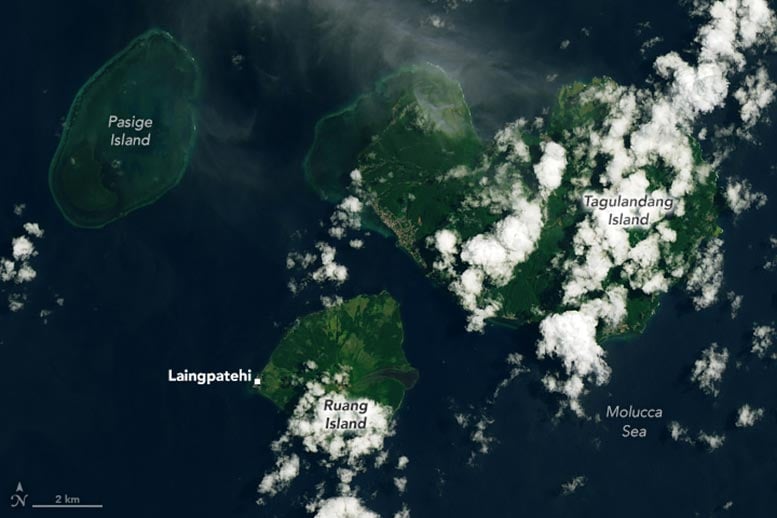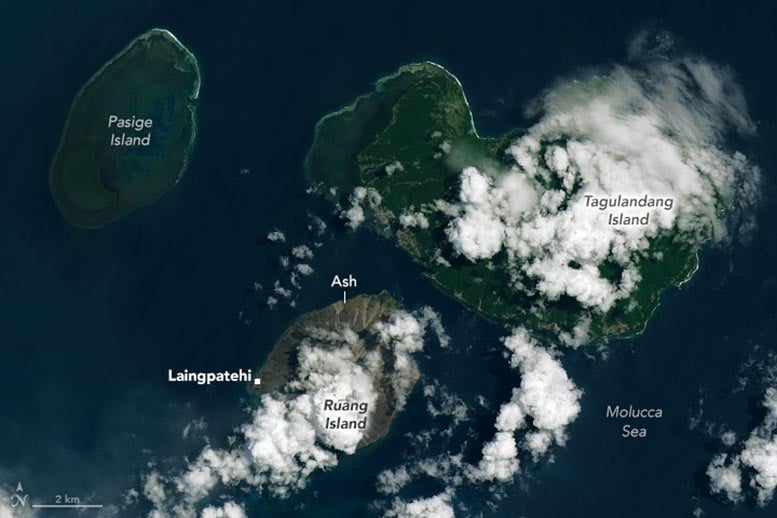
Picture of Ruang before the eruption, taken on April 12, 2024, by the Operational Land Imager-2.

Picture of Ruang after the eruption, taken on April 20, 2024, by the Operational Land Imager.
A strong volcanic eruption sent ash high into the atmosphere and scattered tephra and other volcanic debris across the small island in Indonesia.
Ruang is a small volcanic island in the Sangihe Islands arc in North Sulawesi, Indonesia, which is home to about 800 people. Late on April 16, 2024, the mountain became active, causing a series of explosive eruptions that, at times, sent columns of ash and gas billowing high into the air. stratosphere. The eruption also bombarded covered the island with tephra, small pebbles of lapilli, and fine shards of pulverized rock called ash.
Satellite Observations
The pair of Landsat satellite pictures above show how the eruption changed the landscape. The OLI-2 (Operational Land Imager-2) took a picture on April 12 (upper) that shows Ruang’s lush green vegetation before the eruption; the OLI (Operational Land Imager) picture, taken on April 20 (lower), shows the same area after volcanic debris had covered the island. The picture also shows signs of pyroclastic flows—destructive torrents of hot ash, rock, soil, and gas—that poured down the mountain’s slopes and left thick deposits at the base.
Impact on Local Communities
Settlements on the north side of the island were among the hardest hit with volcanic debris. On the west side, tephra also covered Laingpatehi, the island’s largest village. The bright white features obscuring parts of the island are likely passing clouds, though some of them could be volcanic plumes emitted by the still-active volcano.
According to initial assessments by Badan Nasional Penanggulangan Bencana (BNPB), Indonesia’s disaster management agency, heavy ashfall, and volcanic rock fragments severely damaged or destroyed more than 500 houses. It also damaged crops and farms.
Disruptions and Hazard Management
The ash posed a hazard to aviation, leading to widespread flight cancellations and diversions. Authorities closed the Sam Ratulangi International Airport in the nearby provincial capital of Manado due to the ash, disrupting travel for thousands of people. The airport reopened on April 22, after rainfall washed away ash on the runway, and after BNPB had lowered the volcanic alert level.
Global Observations by Satellites
A geostationary satellite operated by the Japan Meteorological Agency and polar-orbiting satellites operated by NASA and NOAA all observed ash and sulfur dioxide streaming from Ruang as the volcano erupted.
According to Ghassan Taha, an atmospheric scientist at NASA’s Goddard Space Flight Center, data from the Ozone Mapping and Profiler Suite (OMPS) Limb Profiler (LP) show that the volcanic plume reached an altitude of about 20 kilometers (12 miles) and into the stratosphere, the second layer of the atmosphere above the ground. Atmospheric scientists monitor the amount of particles and gases that volcanoes inject into the stratosphere because material reaching this height can spread widely and have global effects on the climate.
Taha stated that aerosol particles are expected to move around in the stratosphere for several weeks or even months.
Atmospheric and Climatic Implications
In the last few decades, volcanic eruptions have released material into the stratosphere about once annually. However, climate experts believe that at least 5 teragrams of sulfur dioxide must be released to create enough aerosol particles to temporarily alter the reflectivity of the upper atmosphere. In most cases, the amount of material reaching the stratosphere has been modest and below that threshold.
Following the eruption at Ruang, an infrared sensor on the geostationary Himawari satellite detected a total emission of about 0.5 teragrams of sulfur dioxide on April 17, as indicated by Simon Carn, a volcanologist at Michigan Technological University. The subsequent day, other satellites measured about 0.3 teragrams. Carn said, “The actual sulfur dioxide emission was probably between 0.3 and 0.5 teragrams, well below the threshold for significant climate impacts.”
The eruption of Mount Pinatubo in the Philippines in 1991, which caused a global cooling of about 0.5 degrees Celsius (0.9 degrees Fahrenheit) for approximately a year, released roughly 20 teragrams of sulfur dioxide into the stratosphere. More recently, the 2022 Hunga Tonga-Hunga Ha’apai eruption released an estimated 0.5 to 1 teragrams.
Historical Context and Recent Eruptions
Ruang, which means “space” or “room” in the local Bugis language, has a long history of erupting and is one of Indonesia’s most active and dangerous volcanoes. Major explosive eruptions have occurred in 1634, 1670, 1843, 1871, 1904, 1956, and 2002, according to the Global Volcanism Program. The 1871 eruption triggered a tsunami that devastated a village on a nearby island and caused hundreds of deaths.
Authorities cautioned that the 2024 eruption could lead to lahars—volcanic mudflows—as rain mixes with fallen ash in the coming days and weeks. The eruption also raised concerns about potential tsunamis from volcanic flows entering the sea, prompting multiple tsunami alerts. However, according to the local volcanic survey (PVMBG) and BNPB, no significant tsunamis have occurred. Indonesian authorities organized the evacuation of over 16,000 residents from areas most at risk of pyroclastic flows, ash falls, and tsunamis. No deaths or injuries have been reported since the eruption began.
NASA Earth Observatory images by Michala Garrison, using Landsat data from the U.S. Geological Survey.



